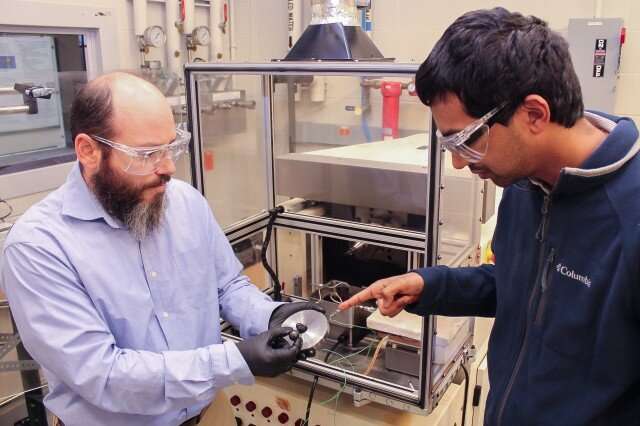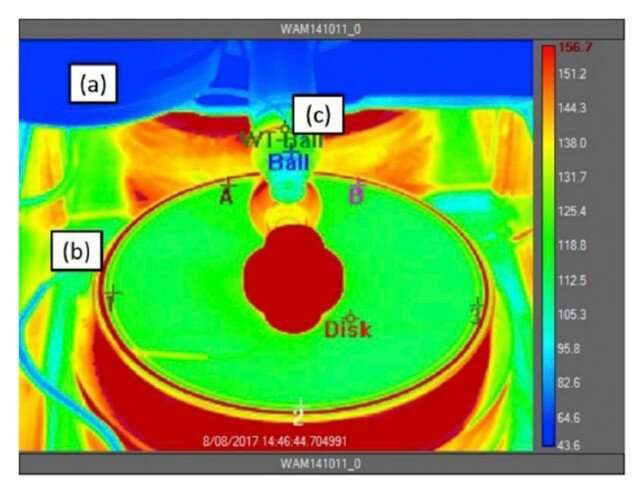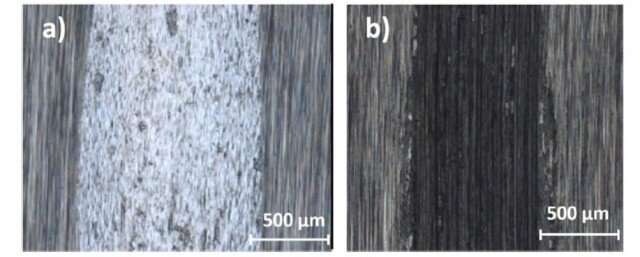Researchers develop new method for analyzing metal

Warfighters on the battlefield often rely on machines, vehicles and other technologies with rotating parts to complete their mission. Army researchers have devised a new method of testing for a major factor in equipment failure and breakdown in order to ensure that those tools meet the proper standard of quality.
When mechanical parts slide against each other for long periods of time, the constant grinding may wear down the metal surfaces until the parts are no longer functional. The study of friction, wear and lubrication as two or more surfaces interact in relative motion is known as tribology, and its importance in material science and engineering has led researchers to find new ways to examine dry mechanical contact.
Researchers at the U.S. Army Combat Capabilities Development Command's Army Research Laboratory recently developed a new approach to analyze the tribological response between steel and silicon nitride that takes place as the two metals interact, rather than after the samples have cooled off.
This latest method of studying wear and tear may allow researchers to observe fleeting chemical reactions that occur at the contact site.
"The mechanical system is very dynamic during operation," said Dr. Stephen Berkebile, Army research physicist. "If it is not captured during operation and, instead, measured when not moving quickly, the transient chemical reactions and physical changes would not be captured since the system may change after cooling down from the frictional heating."
Berkebile acted as one of the Army researchers working together with the University of North Texas to study the sliding interaction between steel and silicon nitride. More specifically, the team was trying to investigate why increasing the sliding speed between steel and silicon nitride decreased their rate of friction and wear as they made contact.
According to the researchers, the interaction between steel and silicon nitride is one that commonly takes place during the dry machining process of certain cutting tools and in emergency situations with high speed bearings when they lose their lubrication source, like those in jet engine turbines. Understanding the kinetics behind the high-speed sliding contact between these two metals would be vital in developing better and safer vehicles and equipment for Soldiers.

"Hybrid bearings with the steel/silicon nitride contact are increasingly being used in turbomachinery within helicopter propulsion systems," Berkebile said. "Such hybrid bearings are finding more and more use in rotorcraft and helicopter propulsion systems where they are operated at high speeds."
The researchers conducted the experiment using a Ball on Disk tribometer that slid a rolling silicon nitride ball against a steel rotating disk that was heated to 120 degrees Celsius with a hot plate underneath.
A stereo-optical microscope with a color Charge-Coupled Device, or CCD, camera and an infrared camera obtained thermal imaging data as the rotating speed of the disk sped up from 1 m/s to 16 m/s. Afterwards, the researchers conducted an analysis of the wear tracks using a backscatter electron detector that mapped the elemental composition of the leftover film residue.
"By combining two optical methods with real-time friction data, we could understand the chemical transition in the wear mechanism," Berkebile said. "We were able to correlate the friction, temperature and chemical state of the mechanical contact during active operation of the experiment as the chemical reaction was occurring."
According to the researchers, this experiment represented the first known attempt to analyze the tribological response of steel and silicon nitride in the middle of a high sliding speed test.
Furthermore, the data resulting from this bold venture provided new information about the nature of tribological effects that took place.
The team discovered that the frictional heating caused at a threshold sliding speed of around 4.5 m/s induced a chemical reaction that left behind a lubricating thin film at the highly loaded contact zone.

This slippery thin film was what allowed the mechanical interaction between steel and silicon nitride to demonstrate lower friction and wear as the sliding speed increased. Using the new approach, the team managed to pinpoint the exact time that the chemical reaction occurred from observations of the wear tracks' color change during the experiment.
Additionally, the researchers determined that this phenomenon is fully active when the sliding speed rose above 9 m/s under gear- and bearing-like conditions.
Based on the analysis of the wear tracks, the researchers verified that a series of oxidation reactions must have taken place as a result of the interplay between iron, oxygen and silicon under high temperatures from frictional heating.
"We found that a smooth transition between one chemical reaction to another occurs during the transition between the low friction and wear state and the high friction and wear state," Berkebile said. "The chemical reaction also requires frictional heating to be maintained, and thus can 'extinguish' itself after a few seconds if the low friction state is achieved and the frictional heating is reduced at intermediate speeds."
According to Berkebile, this new in-situ approach to examining dry sliding mechanical contacts holds the potential to significantly improve the Army's efforts to develop machinery that can better withstand high temperatures, loads and speeds.
"Army helicopters have a requirement to operate for 30 minutes after lubrication has been lost from the drive system," Berkebile said. "From this study, we have learned that for drive systems that contain hybrid components, such as silicon nitride/steel bearings, the materials may actually last longer if they are sliding at a higher rather than lower speed, which is really counterintuitive."
More information: M.D. Harris et al, In-situ instrumentation to observe transient tribological effects in high sliding speed unlubricated contacts, Wear (2019). DOI: 10.1016/j.wear.2019.203111
Provided by The Army Research Laboratory





















